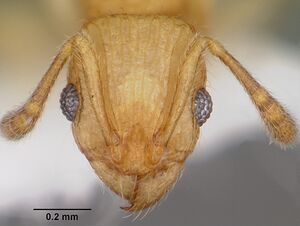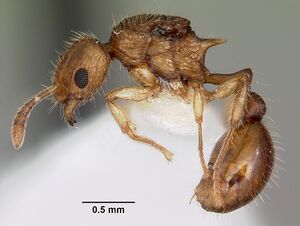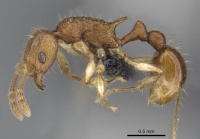Vitsika venustas
| Vitsika venustas | |
|---|---|

| |
| Scientific classification | |
| Kingdom: | Animalia |
| Phylum: | Arthropoda |
| Class: | Insecta |
| Order: | Hymenoptera |
| Family: | Formicidae |
| Subfamily: | Myrmicinae |
| Tribe: | Crematogastrini |
| Genus: | Vitsika |
| Species: | V. venustas |
| Binomial name | |
| Vitsika venustas Bolton & Fisher, 2014 | |
Most examples of venustas were retrieved from leaf litter samples in rainforest, but a few have been found in pitfall traps and yellow pan traps, and a colony was discovered in a dead twig on the ground.
Identification
Bolton and Fisher (2014) - The relatively long, low postpetiole of venustas is also developed in Vitsika labes, but the latter is a larger (HL 0.68–0.77, HW 0.56–0.66, SL 0.48–0.54, MfL 0.60–0.72), more darkly coloured species, in which the eyes tend to be somewhat smaller (EL/HW 0.26–0.29). In reality, the size ranges of the two form a rough continuum, with the upper limits for venustas constituting the lower limits for labes, which raises the possibility that labes is merely a larger morphotype of venustas. Contradicting this possibility is the fact that specimens of both forms have never been retrieved from a single sample, and some series of venustas are extensive. Consequently, the two are regarded as separate species here.
Keys including this Species
Distribution
Endemic to Madagascar.
Latitudinal Distribution Pattern
Latitudinal Range: -14.43388889° to -14.43388889°.
| North Temperate |
North Subtropical |
Tropical | South Subtropical |
South Temperate |
- Source: AntMaps
Distribution based on Regional Taxon Lists
Malagasy Region: Madagascar (type locality).
Distribution based on AntMaps
Distribution based on AntWeb specimens
Check data from AntWeb
Countries Occupied
| Number of countries occupied by this species based on AntWiki Regional Taxon Lists. In general, fewer countries occupied indicates a narrower range, while more countries indicates a more widespread species. |

|
Estimated Abundance
| Relative abundance based on number of AntMaps records per species (this species within the purple bar). Fewer records (to the left) indicates a less abundant/encountered species while more records (to the right) indicates more abundant/encountered species. |

|
Biology
Castes
Males have yet to be collected.
Worker
Images from AntWeb
   
| |
| Worker. Specimen code casent0102972. Photographer April Nobile, uploaded by California Academy of Sciences. | Owned by NHMUK, London, UK. |
Queen
Images from AntWeb
   
| |
| Queen (ergatoid). Specimen code casent0102971. Photographer April Nobile, uploaded by California Academy of Sciences. | Owned by NHMUK, London, UK. |
   
| |
| Queen (alate/dealate). Specimen code casent0104936. Photographer April Nobile, uploaded by California Academy of Sciences. | Owned by NHMUK, London, UK. |
Nomenclature
The following information is derived from Barry Bolton's Online Catalogue of the Ants of the World.
- venustas. Vitsika venustas Bolton & Fisher, 2014: 94, figs. 120-122, Map 162 (w.q.) MADAGASCAR.
Unless otherwise noted the text for the remainder of this section is reported from the publication that includes the original description.
Description
Worker
(holotype in parentheses). TL 2.5–3.1 (3.0), HL 0.56–0.66 (0.65), HW 0.48–0.56 (0.54), CI 81–86 (83), SL 0.40–0.48 (0.48), SI 84–91 (89), PW 0.39–0.46 (0.43), WL 0.70–0.89 (0.84) (20 measured).
Eye with 6–7 rows of ommatidia, and with 7–8 ommatidia in the longest row; EL 0.13–0.17 (EL/HW 0.28–0.30). MfL 0.49–0.60 (MfL/HW 1.02–1.07). Propodeal spiracle small, diameter of annulus of spiracle is usually less than the thickness of the propodeal spine at its midlength. Petiole node in profile more or less erect with respect to the peduncle, the node not obviously inclined posteriorly; node bluntly rounded dorsally, and the anterior and posterior faces converging dorsally. Sculpture of petiole node faint to vestigial laterally, but the side never entirely smooth; posterior surface of node usually with some weak, punctate sculpture on the lower half, but smooth on the upper half. Height of petiole node in posterior view (from midpoint of the dorsal margin of the foramen to the apex) 0.85–1.05 × its maximum width. In dorsal view postpetiole 1.00–1.15 × broader than long; maximum width of postpetiole 1.10–1.25 × the length of a propodeal spine; maximum width of postpetiole 0.90–1.00 × the distance between the apices of the propodeal spines. Postpetiole node in profile relatively long and low, its dorsum shallowly convex; the length of the node in profile visibly greater than the height of the segment. Dorsum of postpetiole never entirely smooth, although the disc may be so. More typically the dorsum with weak superficial punctulae over part or most of its surface, especially posteriorly and laterodorsally, a few weak longitudinal costulae often may also be discernible, especially laterodorsally. Full adult colour yellow to light brownish yellow.
Queen
(gyne). Ergatoid and alate forms are known. Ergatoid HL 0.68, HW 0.56, CI 82, SL 0.48, SI 86, PW 0.46, WL 0.90, MfL 0.58. (1 measured) Worker-like, without ocelli or traces of wing insertions, but with an enlarged mesonotum and a shallow promesonotal impression but no trace of a suture. Mesopleuron without a transverse sulcus. Alate HL 0.66–0.68, HW 0.56–0.58, CI 85, SL 0.46–0.49, SI 82–84, PW 0.50–0.54, WL 0.91–1.00, maximum width of mesoscutum 0.45–0.55, maximum length of mesoscutum 0.48–0.50, MfL 0.58–0.62 (3 measured). With 3 ocelli, a full complement of flight sclerites, and a distinct mesopleural transverse sulcus. Like the workers, the queen also has a relatively small propodeal spiracle and a relatively long, low postpetiole.
Type Material
Holotype worker, Madagascar: Prov. Antsiranana, P.N. Marojejy, 28.0 km. 38° NE Andapa, 450 m., 14°26.2’S, 49°46.5’E, 12–15.xi.2003, sifted litter, rainforest, BLF 8722(9), CASENT0045957 (Fisher et al.) (California Academy of Sciences). Paratypes. 14 workers, 1 ergatoid, and 2 dealate queens, all with same data as holotype and all BLF 8722: workers (L0) CASENT0046161 and 0046179, (3) CASENT0046165, (5) CASENT0045938, (6) CASENT0045942, (7) CASENT0046167, (8) CASENT0046168, (9) CASENT0046169, (12) CASENT0046171, (13) CASENT0046172, (17) CASENT0046174, (19) CASENT0045922, (21) CASENT0046175, (22) CASENT0046177; ergatoid (14) CASENT0046173; dealate queens (L0) CASENT0046178, (18) CASENT0046029 (CASC, The Natural History Museum).
References
- Bolton, B. & Fisher, B.L. 2014. The Madagascan endemic myrmicine ants related to Eutetramorium (Hymenoptera: Formicidae): taxonomy of the genera Eutetramorium Emery, Malagidris nom. n., Myrmisaraka gen. n., Royidris gen. n., and Vitsika gen. n. Zootaxa 3791:1–99. doi:10.11646/zootaxa.3791.1.1
References based on Global Ant Biodiversity Informatics
- Bolton B., and B. L. Fisher. 2014. The Madagascan endemic myrmicine ants related to Eutetramorium (Hymenoptera: Formicidae): taxonomy of the genera Eutetramorium Emery, Malagidris nom. n., Myrmisaraka gen. n., Royidris gen. n., and Vitsika gen. n. Zootaxa 3791(1): 1-99.

